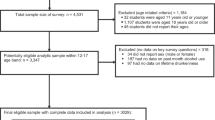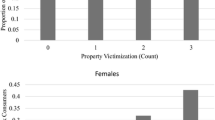Abstract
Objectives
To examine energy drink consumption and its association with demographic characteristics, drug use, and injury among adolescents.
Methods
Data on 4,342 adolescents were derived from the 2011 Ontario Student Drug Use and Health Survey, a province-wide school-based survey of students in grades 7 through 12. The survey was based on a two-stage cluster design and analyses include appropriate adjustments for the complex sample design.
Results
Overall, 49.6% of adolescents had consumed energy drinks in the previous year. A total of 13.8% of seventh grade students had consumed energy drinks in the previous week compared to 19.1% of adolescents overall. Energy drink consumption in the previous year was highly associated with having used tobacco and cannabis in the previous year, the non-medicinal use of prescription drugs in the previous year, and binge drinking in the previous month. Consumption was also highly associated with sensation-seeking and self-reports of medical treatment for an injury (reported by 16% and 42% of adolescents, respectively). The odds of consuming energy drinks did not vary significantly for males and females, and sex was not a significant moderator of the associations examined.
Conclusion
These findings support the need for greater awareness of the extent of energy drink consumption among individual adolescents and the potential that additional health and behavioural risks may be associated with consumption.
Résumé
Objectifs
Examiner la consommation de boissons énergisantes et son association avec le profil démographique, la consommation de drogue et les traumatismes chez les adolescents.
Méthode
Les données sur 4 342 adolescents provenaient du Sondage sur la consommation de drogues et la santé des élèves de l’Ontario (2011), une enquête provinciale menée en milieu scolaire auprès des élèves de la 7e à la 12e année. Le sondage était planifié selon un échantillonnage en grappe en deux étapes, et les analyses ont été adaptées à la complexité du plan d’échantillonnage.
Résultats
Globalement, 49,6% des adolescents avaient consommé des boissons énergisantes au cours de l’année précédente. En tout, 13,8% des élèves de 7e année en avaient consommé au cours de la semaine précédente, contre 19,1% des adolescents dans l’ensemble. La consommation de boissons énergisantes au cours de l’année précédente était fortement associée à la consommation de tabac et de cannabis au cours de l’année précédente, à l’utilisation de médicaments sur ordonnance à des fins non médicinales au cours de l’année précédente et aux excès occasionnels d’alcool au cours du mois précédent. La consommation était aussi fortement associée à la recherche de sensations fortes et aux déclarations autonomes de soins médicaux pour traumatisme (déclarées par 16% et 42% des adolescents, respectivement). La probabilité d’avoir consommé des boissons énergisantes ne variait pas sensiblement entre les garçons et les filles, et le sexe n’était pas une variable modératrice significative dans les associations examinées.
Conclusion
Ces constatations confirment le besoin de mieux connaître l’ampleur de la consommation des boissons énergisantes par les adolescents et la possibilité que cette consommation soit associée à des risques supplémentaires pour la santé et le comportement.
Similar content being viewed by others
References
Wolk BJ, Ganetsky M, Babu KM. Toxicity of energy drinks. Curr Opin Pediatr 2012;24(2):243–51.
Meier B. F.D.A. posts injury data for 3 drinks. The New York Times. November 15, 2012.
Reissig CJ, Strain EC, Griffiths RR. Caffeinated energy drinks–A growing problem. Drug Alcohol Depend 2009;99(1–3):1–10.
Macdonald N, Stanbrook M, Hébert PC. “Caffeinating” children and youth. CMAJ 2010;182(15):1597.
Health Canada. Food and nutrition: Caffeine in foods. Ottawa, ON: Health Canada, 2012.
Babu KM, Church RJ, Lewander W. Energy drinks: The new eye-opener for adolescents. Clin Pediatr Emerg Med 2008;9(1):35–42.
Seifert SM, Schaechter JL, Hershorin ER, Lipshultz SE. Health effects of energy drinks on children, adolescents, and young adults. Pediatrics 2011;127(3):511–28.
Macdonald N, Hamilton R, Malloy P, Moride Y, Shearer J. Report by the expert panel on caffeinated energy drinks. Ottawa: Health Canada, 2010.
Arria AM, O’Brien MC. The “high” risk of energy drinks. JAMA 2011;305(6):600–1.
Miller KE. Wired: Energy drinks, jock identity, masculine norms, and risk taking. J Am Coll Health 2008;56(5):481–90.
Simon M, Mosher J. Alcohol, Energy Drinks, and Youth: A Dangerous Mix. San Rafael, CA: Marin Institute, 2007.
Sepkowitz KA. Energy drinks and caffeine-related adverse effects. JAMA 2013;309(3):243–44.
Popkin B. The World Is Fat: The Fads, Trends, Policies, and Products That Are Fattening the Human Race. New York, NY: Penguin Group, 2002.
Alford C, Cox H, Wescott R. The effects of Red Bull energy drink on human performance and mood. Amino Acids 2001;21:139–50.
Smit HJ, Cotton JR, Hughes SC, Rogers PJ. Mood and cognitive performance effects of “energy” drink constituents: Caffeine, glucose and carbonation. Nutr Neurosci 2004;7(3):127–39.
Substance Abuse and Mental Health Services Administration, Center for Behavioral Health Statistics and Quality. The DAWN Report: Update on Emergency Department Visits Involving Energy Drinks: A Continuing Public Health Concern. Rockville, MD: Drug Abuse Warning Network, 2013.
Miller KE. Energy drinks, race, and problem behaviors among college students. J Adolesc Health 2008;43(5):490–97.
Arria AM, Caldeira KM, Kasperski SJ, O. Grady KE, Vincent KB, Griffiths RR, Wish ED. Increased alcohol consumption, nonmedical prescription drug use, and illicit drug use are associated with energy drink consumption among college students. J Addict Med 2010;4(2):74–80.
Arria AM, Caldeira KM, Kasperski SJ, Vincent KB, Griffiths RR, O’Grady KE. Energy drink consumption and increased risk for alcohol dependence. Alcohol Clin Exp Res 2011;35(2):365–75.
Paglia-Boak A, Adlaf EM, Mann RE. Drug Use Among Ontario Students, 1977–2011: Detailed OSDUHS Findings (CAMH Research Document Series No. 32). Toronto, ON: Centre for Addiction and Mental Health, 2011.
Courser MW, Shamblen SR, Lavrakas PJ, Collins D, Ditterline P. The impact of active consent procedures on nonresponse and nonresponse error in youth survey data: Evidence from a new experiment. Eval Rev 2009;33:370–95.
White VM, Hill DJ, Effendi Y. How does active parental consent influence the findings of drug-use surveys in schools? Eval Rev 2004;28(3):246–60.
Wechsler H, Nelson TF. Binge drinking and the American college student: What’s five drinks? Psychol Addict Behav 2001;15:287–91.
Johnston LD, O’Malley PM, Bachman JG, Schulenberg JE. Monitoring the Future: National Survey Results on Drug Use, 1975–2010: Volume I, Secondary School Students. Ann Arbor, MI: Institute for Social Research, University of Michigan, 2011.
Freeman JG, King M, Pickett W, Craig W, Elgar F, Janssen I, Klinger D. The Health of Canada’s Young Children: A Mental Health Focus. Ottawa: Public Health Agency of Canada, 2011.
Stephenson MT, Hoyle RH, Palmgreen P, Slater MD. Brief measures of sensation seeking for screening and large-scale surveys. Drug Alcohol Depend 2003;72:279–86.
Statistics Canada. Census 2006–2B (Long Form). Ottawa, 2006.
StataCorp. Stata Statistical Software: Release 12.0 [computer program]. College Station, TX: StataCorp, 1985–2011.
Azagba S, Langille D, Asbridge M. The consumption of alcohol mixed with energy drinks: Prevalence and key correlates among Canadian high school students. CMAJ OPEN 2013;E19–E26.
Fogger S, McGuinness TM. Update on energy drinks and youth. J Psychosoc Nurs Ment Health Serv 2011;49(12):17–19.
Health Canada. Health Canada’s proposed approach to managing caffeinated energy drinks. Ottawa, ON: Health Canada, 2011. Available at: https://doi.org/www.hc-sc.gc.ca/fn-an/legislation/pol/energy-drinks-boissonsenergisantes-eng.php (Accessed March 25, 2013).
Author information
Authors and Affiliations
Corresponding author
Additional information
Conflict of Interest: None to declare.
Rights and permissions
About this article
Cite this article
Hamilton, H.A., Boak, A., Ilie, G. et al. Energy Drink Consumption and Associations With Demographic Characteristics, Drug Use and Injury Among Adolescents. Can J Public Health 104, e496–e501 (2013). https://doi.org/10.17269/cjph.104.3998
Received:
Accepted:
Published:
Issue Date:
DOI: https://doi.org/10.17269/cjph.104.3998




